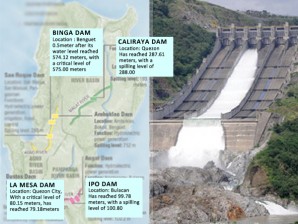Big dams open gates, add to Luzon flooding

Ipo, Ambuklao, San Roque, Binga Dams all opened their gates, according to the Philippine Atmospheric, Geophysical and Astronomical Services Administration (Pagasa).
La Mesa Dam, which has no gate, continued to overflow. As of 2 p.m., its water level was 80.55 meters, above its normal water level of 80.15 m.
Ipo Dam had two gates open yesterday, with its water level as of 2 p.m. reaching 100.97, 0.17 m above its normal high level.
San Roque Dam also had two opened gates, taking in much more water. Its water level as of Tuesday afternoon was 282.96 m, 2.96 m above its normal level.
Pagasa warning
Pagasa warned that the Pangasinan municipalities of San Manuel, San Nicolas, Tayug, Sta. Maria, Asingan, Villasis, Alcala, Bautista, Rosales and Bayambang would be affected when San Roque Dam released water from its spillways.
With two gates open, the water level at Ambuklao dam was 751.88 m on Tuesday, just 0.12 m shy of its limit.
Binga Dam had three open gates as of 2:00 p.m. even though its water level of 573.99 m had not reached its normal high water level of 575 m.
By 6 p.m. on Tuesday, Magat Dam also opened one gate as its water level rose to 191.6 m, 1.6 m above its normal high of 190 m.
Pagasa said the Isabela municipalities of Ramon, San Mateo, Aurora, Cabatuan, Luna, Reina Mercedes, Burgos, Naguilian and Gamu would be affected by water from the dam.
Expected to increase Wednesday
Pagasa said the reservoir water elevations of Ambuklao, Binga, and San Roque Dams were expected to increase until at least today, when moderate to heavy rains were expected to fall over their areas.
The water level at La Mesa in Quezon City fluctuated all Tuesday even as it spilled water.
By 6 p.m. Tuesday, the water level was down to 80.44 m or 6 centimeters lower than its level at 4 p.m., according to Manila Water Co. Inc.
The level was 80.53 m at 3 p.m. and 80.60 m at around 12 noon.
The water steadily rose from Monday night to around 8 a.m. Tuesday and then eased up at around midmorning and started going up again, said Manila Water communications manager Jeric Sevilla.
Spill dam
The same was observed on Monday as the volume of rain went from heavy to light and heavy again.
Water at La Mesa receded toward late afternoon on Monday after hitting its maximum level of 80.15 m in the morning.
La Mesa’s water level reached 80.15 m from 2 a.m. to 7 a.m. on Monday after more than two weeks of heavy rain. The water level dropped steadily during the day and reached 80.11 m as of 5 p.m. but started inching up again after 6 p.m.
Being a spill dam, La Mesa does not have to open its gates to ease water levels. Instead its excess water starts flowing out through a spillway after the 80.15-m mark.
Drain to Manila Bay
During the rainy months, a red alert is raised at 79.50 m, according to Sevilla.
Water from La Mesa goes into the Tullahan River, which flows through the northern part of Quezon City, including the Fairview area, as well as the cities of Malabon, Valenzuela and Caloocan. The river drains into Manila Bay.